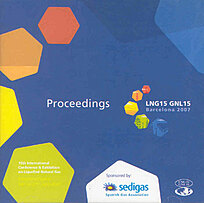
A re-think of the mercury removal problem for LNG plants.
Author(s) : CARNELL P. J. H., ROW V. A.
Summary
Following the mercury induced catastrophic failure of a heat exchanger at Skikda in 1957, the LNG industry had to move quickly to install mercury removal units (MRUs) prior to liquefaction. At that time, the choice of absorbent was limited and MRUs had to be installed at the final stage of purification immediately prior to the cold box. This was not the best arrangement. By not treating the raw gas, mercury was left in co-produced NGLs and might also be released to the atmosphere during processing. Commissioning of new beds lengthened start up and the choice of location added to compression costs. The arrival of new high activity mercury absorbents has allowed the re-thinking of the purification process. The MRU can now be located at the front of the plant to treat the raw gas thus avoiding mercury in NGLs or in emissions. The high activity allows smaller beds to be used and the use of radial flow reactors allows significant savings in compression costs over the traditional axial flow design. The new absorbents can be recycled through an audited disposal route. This paper draws on data from actual operating MRUs to suggest how the design of LNG plants could be improved.
Details
- Original title: A re-think of the mercury removal problem for LNG plants.
- Record ID : 2008-1117
- Languages: English
- Source: LNG 15. Proceedings of the 15th International Conference and Exhibition of Liquefied Natural Gas.
- Publication date: 2007/04/24
Links
See other articles from the proceedings (43)
See the conference proceedings
Indexing
-
Themes:
LNG and LPG;
Applications of liquified gases - Keywords: Mercury; Recovery; Process; LNG
-
Economic and environmental benefits of two-phas...
- Author(s) : PERLMUTTER M. J., KIMMEL H. E., CHIU C. H., et al.
- Date : 2004/03/21
- Languages : English
- Source: LNG 14. Proceedings of the 14th international conference and exhibition of liquefied natural gas [CD-ROM].
View record
-
Natural gas liquefaction processes comparison.
- Author(s) : MARTIN P. Y., PIGOURIER J., FISCHER B.
- Date : 2004/03/21
- Languages : English
- Source: LNG 14. Proceedings of the 14th international conference and exhibition of liquefied natural gas [CD-ROM].
View record
-
STRATEGIES FOR HANDLING MERCURY AND RELATED PRO...
- Author(s) : SOEMANTRI H., SOERYANTO J.
- Date : 1989/10/17
- Languages : English
View record
-
LE PROCEDE TECHNIP DE RECUPERATION CRYOGENIQUE ...
- Author(s) : PARADOWSKI H., CASTEL J.
- Date : 1987/08/24
- Languages : French
- Source: Development in refrigeration, refrigeration for development. Proceedings of the XVIIth international Congress of Refrigeration.
- Formats : PDF
View record
-
Recupero energetico dagli impianti di rigassifi...
- Author(s) : MESSINEO A., PANNO G.
- Date : 2009/06/12
- Languages : English
- Source: Latest technologies in refrigeration and air conditioning: energy issues and climate change, new refrigerants, new European regulations, new plants, the cold chain. XIII European Conference: June 12-13, 2009, Milan.
- Formats : PDF
View record
